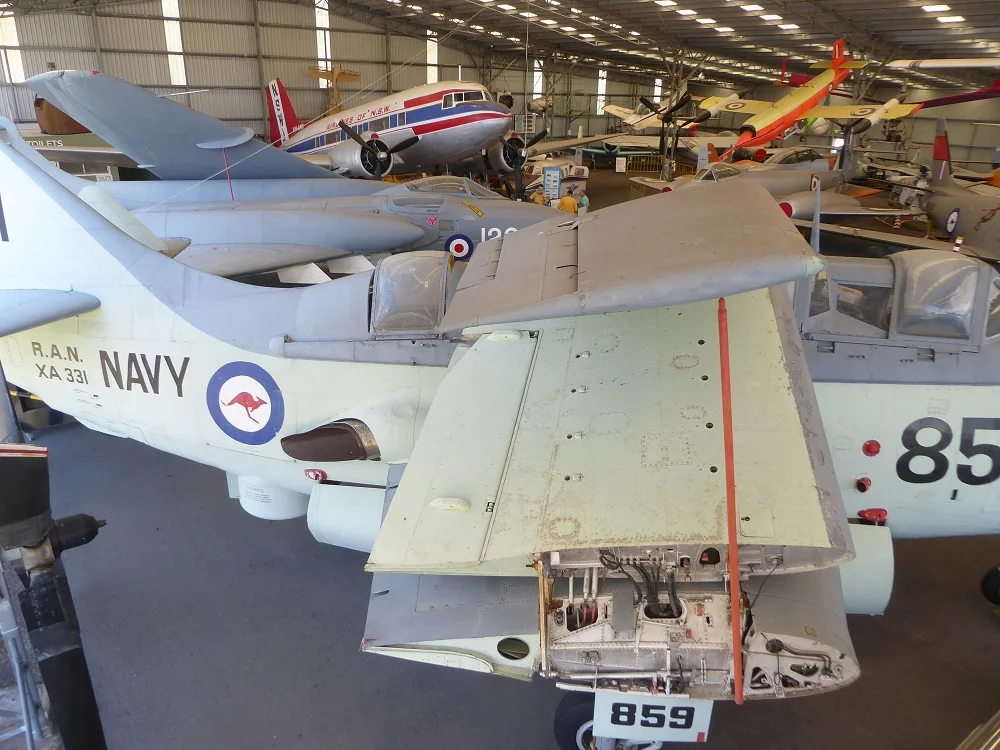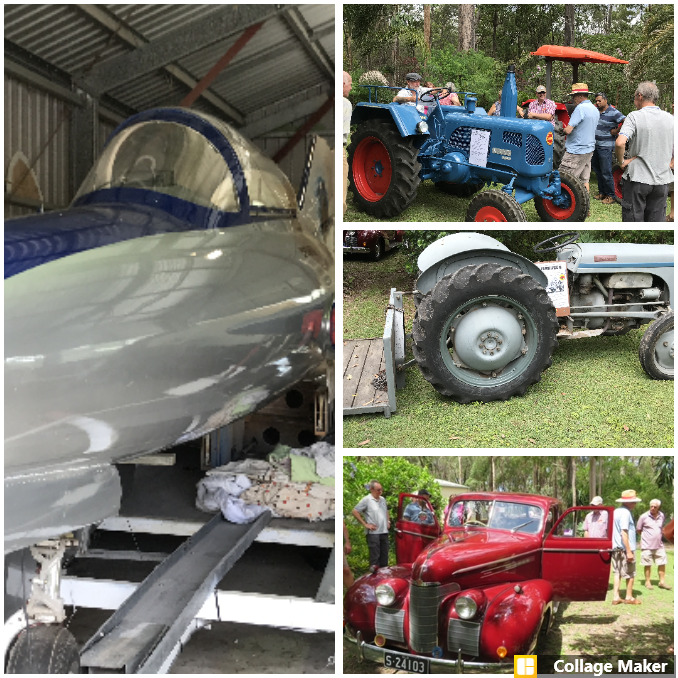NGVR Military Museum

New Guinea Volunteer Rifles Military Museum Day
It was a typical hot Brisbane day when we made our way to the Military Museum of the New Guinea Volunteer Rifles & Papua New Guinea Volunteer Rifles Ex-members Association Inc. Getting up to 34 degrees (and it is still only Spring!) it was comforting to find out upon arrival that the museum was air conditioned. Whilst most travelled from the club house, others travelled direct to the museum. There was only one casualty, Don and Irene’s A30 that decided it just was not the day to be out in the heat. We all hope that the issue is found and sorted quickly so it’s back on the road soon.
Keeping in line with the weather, we were warmly welcomed by the museum volunteers upon our arrival and after a brief inspection of our vehicles by the museum volunteers (John, a museum volunteer) was disappointed that there was no A30 amongst us), we had some morning tea on the veranda of the museum. The coffee and tea was supplied by the museum and we brought our own biscuits and cakes etc.
Upon entry to the welcomed air conditioned museum we all signed the visitors book. We were then taken in groups of 5 around the museum by the museum volunteers and provided with a great education on New Guinea’s part in WW2. What made the presentation by the volunteers particularly special, for me, was that each of them had a personal connection to New Guinea and to the war, with close family members serving in New Guinea, mostly as part of the NGVR.
The fateful story of the Montevideo Maru
The first story, that the group I was part of was told, was of Australia’s worst naval disaster and as it was pointed out, was not the sinking of the HMAS Sydney (which, of course, was terrible and a great loss). It was the story of the torpedoing and sinking of the Japanese prisoner of war ship, Montevideo Maru, in the South China Sea on 1 July 1942, by the allied submarine, USS Sturgeon. This tragedy resulted in the loss of 1,053 Australian Soldiers and civilians, including some 80 NGVR personnel. The men on the Sturgeon had no idea for many, many years that they had sunk a Japanese ship with so many allied forces on board and it was told to us of the trauma that those men had experienced since learning of this terrible truth. It was also moving to hear of the story of one of the few surviving Japanese officers from the Montevideo Maru, that whilst the ship was sinking, could hear the trapped soldiers on the lower decks, certainly knowing that they were soon to die, all singing together “Old Lang Syne”. There was also the moving story of Barry O’Neil, who was one of the causalities. He had been writing continuously to his girlfriend, Grace, but the letters stooped and Grace did not know why. When he was made to board the fateful Japanese prisoner of war ship, Barry threw his handkerchief over the side of the ship and it was picked up by a local young boy. It was many years later presented to the museum, who found Barry’s Grace and when showing her his handkerchief (which he had written his name on) and telling her of the story, uttered the words “now I know what happened to you”. I think many of us could have done with a handkerchief after hearing that story. And finally we were told of the uplifting dedication of the memorial in Canberra to those who lost their lives that fateful day in 1942, where upon the completion of the ceremony a rainbow appeared, as if to say thank you from those lost soldiers for simply being remembered.
The nurses vital contributions
There were many other very interesting stories told by each of the volunteers, including a display about the substantial contribution of nurses during conflicts. We were all reminded of the heroic story of Sister Vivian Bullwinkle, an Australian army nurse who survived the sinking of the Vyner Brooke in 1942 only to become the sole survivor when the Japanese massacred 21 army nurses. She was later taken as a POW and survived to become one of Australia’s most distinguished women. Also, Sister Berenice, who was in Rabaul at the time of the Japanese occupation, survived the war and continued her service in New Britain until her retirement to Sydney. Sister Berenice celebrated her 100th birthday on November 9, 2016 and was featured on Channel 7 news. Her and her fellow captive Lorna Who, life story inspired the ABC TV Movie Sisters of War.
Weapons of war
We were also fascinated by a demonstration and explanation of some of the many weapons (all non-working) in the museum’s collection. These included machine guns from various fighter planes, a Brenner gun, hand grenades and mortar shells. I also found an interesting manual for soldiers titled, “Soldier’s Handbook for Defense Against Chemical and Biological Operations And Nuclear Warfare”.
Spread the word
After our very informative presentations, we then adjourned for a wonderful BBQ lunch, cooked and prepared by the volunteers, back on the veranda of the museum. After lunch we were able to spend our own time looking back through the museum and asking more questions of the volunteers. When we left, I am sure that all had enjoyed the visit and drove out the gates just a little bit more knowledgeable and greatly appreciative of the museum volunteers and the important and selfless work that they do in not only maintaining and preserving the museum, but also ensuring current and future generations are aware of the heroic deeds and sacrifices made by those of the NGVR and all who defended Australia during war. We also wish to thank Allan Waller for organising the visit. As asked by the museum volunteers, be sure to spread the word, especially amongst children and their schools to encourage them to visit and support the museum.
About the NGVR and the Museum (sourced from the Museum’s information pamphlet)
The Museum was established in 2005 in leased premises within the Wacol Military Heritage Precinct. The original WW2 building has been refurbished, air conditioning added and a recent extension. The museum contains many military displays and displays about NGVR’s wartime activities and other Australian Military campaigns in the PNG Archipelago. The purpose of the museum is to provide a lasting tribute to NGVR and a memorial to the men who were lost in the Pacific War. Importantly, the museum is to provide a growing community facility for the benefit of future generations. The museum has links to the Victoria Barracks and MacArthur Museums in Brisbane City, with inter-loans of exhibits and items regularly arranged.
NGVR had the distinction of being the only Australian army militia unit raised, mobilised, fought and disbanded overseas in the Mandated Territory of New Guinea between 1939 and 1943. It consisted of a cosmopolitan group of men from Europe, the British Isles, New Zealand, Australia and Asia, whose homes and livelihoods were in New Guinea. Initially consisting of 20 Officers and 400 other ranks, it was expanded in June 1940 to 23 Officers and 482 other ranks. NGVR made substantial contributions in many conflicts with the Japanese in New Guinea, including when the Japanese first landed at Rabaul in the early hours of 23 January 1942; Lae on 8 March 1942, where NGVR withdrew across the Fancisco River and destroyed the bridge, assuming responsibility for several thousand indentured labourers recruited from nay outlying districts, establishing a depots to feed them all; a successful raid of 71 members of the NGVR and 2/5th Independent Company on the Japanese on 29 June 1942. By early 1943 too few were left to be effective and the remaining NGVR soldiers were attached to the Australian New Guinea Administrative Unit and NGVR lost its identity.
The NGVR soldiers came from many walks of life. While some were too old to join the AIF, medically unfit or employed in restricted occupations, they fought well. They also initiated the organising Papua New Guinea labour, which was to become a vital contributory feature to the success of the Allied campaign in the New Guinea archipelago.
Further information
Visit www.pngvr.weebly.com or search “ngvr and pngvr military museum” on facebook.








